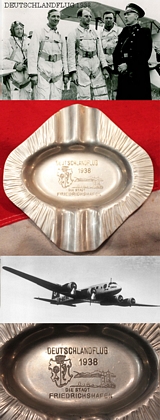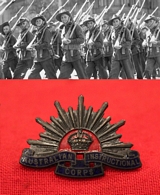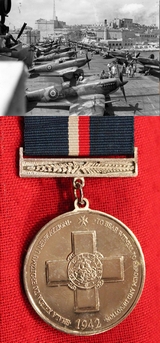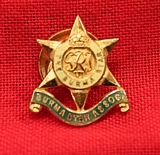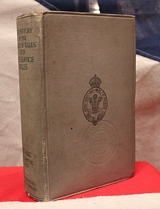A Fine Prussian Military Honour Medal In Silver 1814.
A large silver medal on its original silk ribbon. King Fredrick William III's Ehrenzeichen (honour medal). The inscription "VERDIENST UM DEN STAAT" (Meritorious Service to the State) which appears in the centre of the medal surrounded by a circular wreath of laurel leaves remained unchanged from its inception in 1814 until 1918. To better appreciate the reason why this particular decoration survived virtually unchanged as a continuous service award for subsequent Prussian kings and German Emperors after Friedrich Wilhelm III's death in 1840, to even include the retention of his initials, it may be helpful to understand the historical importance and context of his rule to the eventual founding of the German Empire.
In furtherance to this, King Frederick William III (1770-1840) succeeded to the throne of Prussia in 1797, at the age of 27, during the French Revolution. Fearful of the possible spread of democratic concepts to Prussia, he attempted to maintain a policy of strict neutrality in the political and military conflicts which were constantly taking place at that time between the new French republic and her bitter enemies in the long standing monarchies of Austria and England. Medal 1.5 inch across. Silver weight 25 grams approx. read more
110.00 GBP
Volunteer Artillery Busby Plume Holder Badge circa 1860 to 1873.
Other ranks nickel badge with slide to the reverse. Following the Crimean War, it was painfully clear to the War Office that, with half of the British Army dispositioned around the Empire on garrison duty, it had insufficient forces available to quickly compose and despatch an effective expeditionary force to a new area of conflict, unless it was to reduce the British Isles' own defences. During the Crimean War, the War Office had been forced to send militia and yeomanry to make up the shortfall of soldiers in the Regular Army. The situation had been complicated by the fact that both auxiliary forces were under the control of the Home Office until 1855.
Tensions rose between the United Kingdom and France following the Orsini affair, an assassination attempt on Emperor Napoleon III on 14 January 1858. It emerged that the would-be assassin, Felice Orsini had travelled to England to have the bombs used in the attack manufactured in Birmingham. The perceived threat of invasion by the much larger French Army was such that, even without sending a third of the army to another Crimea, Britain's military defences had already been stretched invitingly thin. On 29 April 1859 war broke out between France and the Austrian Empire (the Second Italian War of Independence), and there were fears that Britain might be caught up in a wider European conflict read more
110.00 GBP
An American, Goodyear Co. Ashtray Made From Duralumin From Airship Akron
A 1931 souveninir of USS Akron (ZRS-4). Striking and very rare. It was a helium-filled rigid airship of the U.S. Navy which operated between September 1931 and April 1933. She was the world's first purpose-built flying aircraft carrier, carrying F9C Sparrowhawk fighter planes which could be launched and recovered while she was in flight. With an overall length of 785 ft (239 m), the Akron and her sister ship the Macon were among the largest flying objects ever built. Although the LZ129 Hindenburg and the LZ130 Graf Zeppelin II were some 18 ft (5.5 m) longer and slightly more voluminous, the two German airships were filled with hydrogen, so the US Navy craft still holds the world record for helium-filled airships.
The Akron was destroyed in a thunderstorm off the coast of New Jersey on the morning of 4 April 1933, killing 73 of the 76 crewmen and passengers. This accident involved the greatest loss of life in any airship crash. The airship's skeleton was built of the new lightweight alloy duralumin 17-SRT. The frame introduced several novel features compared with traditional Zeppelin designs. Rather than being single-girder diamond trusses with radial wire bracing, the main rings of the Akron were self-supporting deep frames: triangular Warren trusses 'curled' round to form a ring. Though much heavier than conventional rings, the deep rings promised to be much stronger, a significant attraction to the navy after the in-flight break up of the earlier conventional airships R38/ZR-2 and ZR-1 Shenandoah. The inherent strength of these frames allowed Chief Designer, Dr Karl Arnstein, to dispense with the internal cruciform structure used by Zeppelin to support the fins of their ships. Instead, the fins of the Akron were cantilevered: mounted entirely externally to the main structure. Zeppelin and other rigid designs used a single keel at the lowest point of the hull circumference but Arnstein gave the Akron three keels, one running along the top of the hull and one each side, 45 degrees up from the lower centreline. Each keel provided a walkway running almost the entire length of the ship. The strength of the main rings, the lower keels, and the fact that helium, instead of flammable hydrogen, was to be used, also allowed the designer to mount the engines inside the hull, improving streamlining. read more
145.00 GBP
An NSFK German Flight of 1938 Souvenir Ashtray Of Aeronautical Alloy
The Deutschlandflug 1938 [German Flight] was the largest international aerospace event in the world. The German flight in 1937 was the first large-scale aviation event after the armament of the Wehrmacht and was organized by the National Socialist Air Corps (NSFK). The airmen did not participate individually, but in triple associations, of which 62 were at the start; 61 of these also reached the goal. The associations did not collectively share a previously defined route, but were able to choose their flight route themselves to fly more than 70 established destinations. On four days of the contest, the three groups broke up and the planes flew individually. [8th]
The German Sportflieger stated: "No human life in this competition is to be deplored, which put the highest demands on machines and crew, which also had still Orter tasks and skill tests (target dropping and obstacle landings) after six exhausting flight days" ]
On the German flights of 1934, 1935, and 1937, only three- to seven-aircraft units participated. In 1937, private pilots also launched their own aircraft. The 1938 German Flight was the largest international aerospace event in the world, with some 400 aircraft taking off and spending a total of around 2,500,000 kilometers on eight competitions. In this competition, both the route and the airfields were selected. Due to the inexperience of many pilots as well as bad weather, several serious accidents occurred.
The German flight planned for 1939 no longer came to the rescue. The German flight is a competition for aircraft pilots , which was carried out for the first time from 11 June to 10 July 1911. On the following flights to Germany, pilots took part, whose names should be included in the history of aviation. Names such as Ernst Udet or Elly Beinhorn are featured on the lists. In the time of National Socialism the flights became gigantic performance with up to 400 participating aircraft. The N.S.F.K. (National Socialist Flying Corps) was created in January of 1932, to promote interest in aviation throughout Germany. It was a male dominated association, although females were not discouraged from participating in events. The NSFK was very closely associated with the Hitler Youth (HJ) organization. read more
165.00 GBP
A German WW2 Kriegsmarine Coastal Artillery BeVo Breast Eagle
Green ground with yellow eagle. A nice original Kriegsmarine yellow example. Coastal artillery was the responsibility of the Kriegsmarine, and most of the weapons employed in this manner were captured or obsolete weapons, their role was a defence against invasion, rather than proper coast defence against naval attack many of these guns were mounted in defensive works of either turrets or casemates. Marine Artillery Units were trained as ground artillery. There are several accounts of Naval Artillery Forward Observers during the Market Garden operation. Coastal batteries were used against ground targets all the way up the French coast, that is, if they could be turned towards the landward side.
Also, something to keep in mind, Naval Artillerymen are trained to hit moving targets such as ships, not much of a stretch to hit relatively stationary ground targets and the like such as a battalion area or a road junction. Coordinates, angles, grids, and trajectories are calculated much the same and a big shell is a big shell regardless of the target? read more
65.00 GBP
WW2 Australian Instructional Corps - Officer Bronze and Enamel Hat Badge
A mighty rare badge of WW2. Australian Instructional Corps - Officer Bronze and Enamel Hat Badge 1921 - 55. Worn from 1930 to 1942.
The Australian Instructional Corps (AIC) was the permanent force posting unit for the Warrant Officer Instructors of the Australian Army from 1921 to 1955. Complete with two lugs.
A highly desirable hat badge. These were worn by Warrant Officer trainers who were responsible for the training of the Militia Battalions and Regiments (Citizen Military Forces) from 1921 to 1942 and the Volunteer Defence Force (VDF) from 1942 to 1945 as well as the 2nd AIF post 1939.
The AIC ran qualification courses for militia and AIF officers and NCOs at specialist schools across the country.
Many of the instructors were commissioned as Officers or were employed as senior NCO's in these war time formations.
The AIC reached its peak in 1942 with 234 quartermasters and 889 warrant officers so both types of these insignia can be quite hard to come by read more
245.00 GBP
Malta's British Empire 'George Cross' for Heroism Commemorative Medal
Available to veterans who served in Malta between the dates of 10th June 1940 and 8th September 1943 to be worn with pride not alongside gallantry decorations, but separately and distinctively.
In April of 1942 King George VI in a dramatic and unprecedented gesture conferred the George Cross medal on the tiny Mediterranean island of Malta.
As it transpired April was the final month of the great Luftwaffe offensive and possibly the most difficult period of the siege so devastatingly enforced by the Axis powers. The island and its population had been subjected to a constant and unrelenting bombardment since June 1940 and were not to experience any relief from these conditions until the final months of 1942 when supplies and aid began to reach the defenders in significant quantities.
All over the world the people of the United Nations had followed the resistance of the islanders and those trying to bring aid by sea and air. The news of the award of the George Cross was internationally welcomed as it served in a tangible way to mark the heroism of all concerned.
The Government of Malta dignified the fiftieth anniversary of the presentation of the George Cross to the island in 1942 by striking the 'Malta George Cross Fiftieth Anniversary Commemorative Medal'. The closing date for application was 15th April 1994.
Next of kin could also apply for the medal which would only have been issued on receipt of a completed application form and proof of service in Malta between the dates of 10th June 1940 and 8th September 1943.
The colours of the ribbon, two narrow stripes of white and red on a background of blue, are representative of the Malta flag and the George Cross. read more
95.00 GBP
WW2 Burma Star Association Lapel Badge
The Burma Star Association was officially founded on the 26 February 1951 with 2,000 founder members. The badge of the Association incorporates a replica of the Burma Campaign Star. Permission to take advantage of this singular honour was supported by His Majesty King George VI in consultation with Earl Mountbatten and Field Marshal Viscount Slim and the badge and title were accepted by the College of Heralds. This fact recognises the rigorous nature of climate, topography and the extremely debilitating conditions in which to wage a successful campaign against a determined and fanatical enemy, thus making this Association unique among post war ex-Service Associations.The first President of the Association was Field Marshal Viscount Slim (Uncle Bill) who held this position until his death on 14 December 1970. read more
15.00 GBP
A Pair of Franco Period Late1930's Spanish Nationalist Officers Epaulettes
On green wool cloth with gilt bullion. read more
95.00 GBP
History of the Prince of Wales Own Civil Service Rifles
Published in 1921 principally the detailed history of the regiment, the men who served and who died in the Great War. The original Westminster City Reference Library copy [offically withdrawn]. A superbly detailed work of one of the famous volunteer regiments of WW1. read more
75.00 GBP





